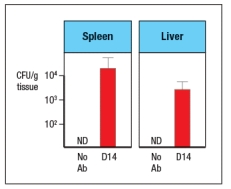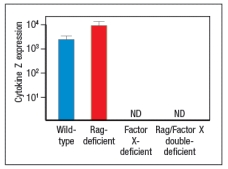Like wild-type (WT) mice, Rag-deficient mice have large numbers of commensal microbes in their gastrointestinal (GI) tract that remain contained in restricted to anatomical locations associated with the GI tract. However, when Rag-deficient mice are treated with a depleting antibody that eliminates all lymphocytes from the animals, these mice suffer from dissemination of commensal bacteria to peripheral organs, such as spleen and liver, and show evidence of systemic inflammation as shown by cytokine levels in the serum. ND, not detected; D3, day 3 post-antibody injection; D14, day 14 post-antibody injection. 
a) What are the cells in Rag-deficient mice, that, when depleted by the antibody injection, cause bacterial dissemination and systemic inflammation?
In a follow-up study, the Rag-deficient mice were treated with a blocking antibody to neutralize a cytokine (cytokine Z) known to be produced by lymphocytes. On day 14 post-antibody injection, the spleen and liver of the mice were analyzed for numbers of bacteria, and the results are shown in Figure : 
b) What is the likely identity of cytokine Z?
In a second follow-up study, Rag-deficient mice were crossed to a knockout for a transcription factor (Factor X) also known to be expressed in some lymphocytes. Lamina propria lymphocytes were isolated from wild-type mice, Rag-deficient mice, Factor-X-deficient mice, and double Rag/Factor-X deficient mice, and mRNA was prepared from the cells. RT-PCR was then used to determine the mRNA transcript levels for cytokine Z in all four lymphocyte populations, and the results are shown in Figure. 
c) What is the likely identity of Factor X?
In a final experiment, the entire small intestine of wild-type mice, Rag-deficient mice, or Factor X-deficient mice is isolated and processed for mRNA, which is then used in RT-PCR experiments. Expression levels of mRNA encoding RegIII and RegIII are assessed in these samples; the results are shown in Figure. 
d) What do these data indicate about the regulation of RegIII and RegIII expression? Which cells are expressing RegIII and RegIII ?
Definitions:
Solute Molecules
Molecules dissolved in a solvent to form a solution, playing crucial roles in chemical and biological processes.
Kidney Dialysis
Kidney dialysis is a medical procedure that mimics the function of the kidneys by removing waste products and excess fluid from the blood when the kidneys are no longer able to do so.
Semipermeable Membrane
A semipermeable membrane is a type of biological or synthetic, polymeric membrane that will allow certain molecules or ions to pass through it by diffusion and occasionally specialized "facilitated diffusion".
Concentration Gradient
A concentration gradient is a variation in the concentration of a substance across a region, leading to the movement of particles from high to low concentration areas.
Q2: Mechanism of peripheral tolerance of B cells
Q3: The C3 convertase of the alternative complement
Q4: Each family of NK cell receptors has
Q9: A child who suffers from a persistent
Q13: B and T lymphocytes develop from multipotent
Q20: Hypersensitivity responses to divalent cations such as
Q23: The TNF family of cytokines and
Q25: When mice are born, their intestinal lamina
Q42: Defects in components of the complement pathway
Q77: Why are long range predictions considered essential